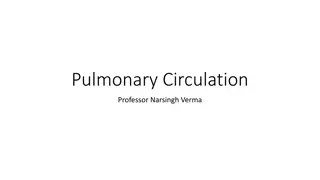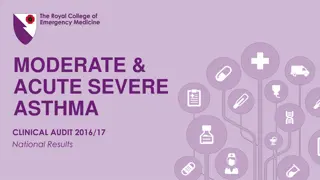Evolution of Circulation Audit Bureaus and Verification Process in Media Industry
Circulation Audit Bureaus are industry-sponsored organizations that verify and report publication circulations. The history dates back to the late 1800s when they were established to address inflated circulation figures. The verification process involves audits and adherence to standards set by the organization, ensuring accurate circulation data for advertisers and publishers alike. These bureaus play a crucial role in providing transparency and credibility in the media industry.
Download Presentation

Please find below an Image/Link to download the presentation.
The content on the website is provided AS IS for your information and personal use only. It may not be sold, licensed, or shared on other websites without obtaining consent from the author. Download presentation by click this link. If you encounter any issues during the download, it is possible that the publisher has removed the file from their server.
E N D
Presentation Transcript
Circulation Audit Bureaus Information Studies 180: Ecology of Information Instructor: Dr. John Richardson October 22, 2008 Ross Moody
What are Circulation Audit Bureaus? - Definition from IFABC: Industry-sponsored organizations established to verify and report facts about the circulations of publications and related data (International Federation of Audit Bureaux of Circulations 2008). - Private, non-profit associations of advertisers and print media publishers - Have purposes for both advertisers and media alike - Act as CRAs for advertisers
Circulation Bureau History Around 1860- publishers beginning to promote their newspapers to and negotiate with advertisers using circulation figures (Moseley 2002). 1899- American Association of Advertisers established- tried to compel publications to furnish statements, give access to auditors notes. By 1900, daily newspaper circulation has passed (allegedly) 15 million; 2,150 daily newspapers operating in U.S (University of Minnesota 2008). No private compacts or public code governing research, publication of circulation figures. Consequence: inflated figures, or none at all (Moseley 2002). Advertisers frustrated --> 1914- Establish the U.S. Audit Bureau of Circulations with help of advertising agents.
Circulation Bureau History (continued) British follow suit in 1931 (same name), national and international CABs established around the world throughout 20th century, including IFABC in 1963. Organizations formulated for standardizing Internet measurement throughout late 1990s, incorporated by IFABC.
Verification Process 1) Publisher meets circulation requirements, pays fee (goes to appointment of auditors, in-house services, training). 2) Board elects to issue membership certificate. 3) Publisher undergoes audits; nature of auditor can vary-- can be both in-house and independent 4) Rules of auditing: Publishers must furnish statements (weekly, monthly, yearly averages, quarterly geographic reports, prices) Bureau-appointed auditors must have access to all records Publisher must maintain standards of record storage and reporting frequency Publisher must maintain subscription, reward practices Publishers must follow sampling standards for telephone, internet surveys Info must be confidential 5) CABs examine audit, compare to publisher s statement--> issue certification or punish. 6) Reward for publishers: easy access to accurate circulation figures of rivals; non-paid associated newspapers attract advertisers.
Organization Judiciary and Legislative- Mix of members and executives: Can vote on rules in certain cases Appointed to undertake investigations With consent of Board, can take action against paties Advisory: Suggest rules to be taken up by Board of Directors Media advisory and liaison committees Media buyer (individual companies as well as advertisers) advisory and liaison committees Executive- Board of Directors: Advertiser divisions Publisher divisions Annual democratic elections among members Hear complaints and appeals Rule implementation-- can be immediate, conditioned w/ feedback or voted on by majority of membership
Current Issue: Circulation Decline 2006-2007: Print advertising revenue down 9.4% US (Mullaney 2008); EU- readership down 2.37% (World Association of Newspapers 2008). Same period-- U.S. newspapers down 2.6% (weekly avg.), 3.5% Sundays nationwide; some 2nd-tier papers (Boston Herald) down more than 1st-tier (Boston Globe) (Johnson 2008). Responses by CABs from 2006-2008 (latest annual meeting): Regional papers (below 50,000 readers) can undergo circulation audits every two years, rather than annually; no geographic requirement Regional papers can opt out of daily audits, larger papers (between 50-75k) can undergo audits bi-annually w/ conditions More subscription upgrades Lack of zip code reporting for national newspapers Flexibility in effectively offering more ad-space Digital editions can be included Total average circulation added in reports However: Stricter accountability in adding subscriptions New reader classes added to verified circulation for all newspapers Overall impact: Automatic increase in circulation figures, less-specific figures.
Current Issue: Internet Growth Internet: Online readership up 31% in U.S., 2005-2006 (Reuters 2006); UK- Times Online (92% increase), Guardian (46%), Sun (51%) (ABCe 2008). Online CABs : U.S.: Nielsen Online; U.K.- ABCe (both founded 1996); Internet Advertising Bureaus (IAB) worldwide (France, Argentina, etc.). Software use, direct auditing by Nielsen (using IAB parameters). Problems: In 2006- Bots- Responsible for up to 40% of ad impressions; cookie- clearing- Inflation of up to 1000% per month (Internet Advertising Bureau 2006). Possible globally-based conflict of interest (e.g. FreeRice) No newspaper publishing companies involved with setting rules Solutions: Create bot and spider lists--> create filtering programs to deduct visits
Works Cited ABCe. August 2008. ABC Multi-platform Report. ABCe. http://www.abce.org.uk/cgi- bin/dmr.cgi?runprog=abce/abce&o=&c=&type=subreports&pfile=Multi_Platform/Multi_Platfor m_Report_2008-08.pdf&menuid=abce_database|multi&breadcrumbonly (accessed Oct. 14, 2008). International Federation of Audit Bureaux of Circulations. IFABC home page. IFABC. http;//www.iifabc.org/ (accessed Oct. 13, 2008). Internet Advertising Bureau. February 6, 2007. IAB And ABCE Announce Global Spiders & Bots List. IAB, http://www.iab.net/about_the_iab/recent_press_releases/press_release_archive/press_relea se/4924 (accessed Oct. 15, 2008). Johnson, Carolyn Y. November 6, 2007. Newspaper circulation still on decline. Boston Globe. http://www.boston.com/business/globe/articles/2007/11/06/newspaper_circulation_still_on_d ecline/ (accessed Oct. 14, 2008). Mullaney, Tom. March 28, 2008. Newspaper Print Ad Sales Fall 9.4%, Most on Record (Update2). Bloomberg.com, http://www.bloomberg.com/apps/news?pid=20601103&sid=abN6GoHxaz2E (accessed Oct. 13, 2008). University of Minnesota Media History Project. University of Minnesota Media History Project, 1900-1909. University of Minnesota, http://www.mediahistory.umn.edu/timeline/1900- 1909.html (accessed Oct. 15, 2008). World Association of Newspapers. June 2, 2008. World Press Trends: Newspapers Are a Growth Business. World Association of Newspapers, http://www.wan- press.org/article17377.html (accessed Oct. 14, 2008).
Issues for Consideration The definition of a newspaper? What business are they in? Everything is finite! Do people still value physicality? Looking to leaders in the field and other countries for inspiration....
DEFINITIONS ARE IMPORTANT! A daily or weekly publication consisting of folded unstapled sheets and containing news, articles, and advertisements. A newspaper is a written publication containing news, information and advertising, usually printed on low-cost paper called newsprint.
What makes them the same/different?? Tonality Perceived legitimacy Size, layout, imagery Content ????????????
THE NEWSPAPER CAKE What are the essential ingredients? What could we add/remove based on the evolving information seekers needs and wants?
Newspaper is the only medium which generally does not attempt to target a niche... - Think TV, magazines etc Some Niche Paper Ideas?? - Pick and mix newspaper - Teen news
Where does the majority of newspapers earnings come from? 36 million free papers are distributed daily in 49 countries. In Spain 51% of newspaper circulation is free. Spain's 20 Minutos Pioneer in the free newspaper space in Western Europe Now Spain s most distributed newspaper Is (free) the key reason why the Bruin is successful? http://www.pbs.org/mediashift/2007/08/free-newspapers-lead-way-online-in-europe229.html
Similar style to USA Today - Short precise news - Main stream advertising/doesn t rely on classifieds Targets a niche - Time conscious - Young professionals - Use public transport - Aspirational What can you observe? - Headlines - Layout - Content - Size
MX says: -mX has tapped into a unique audience of young, time starved individuals who are increasingly difficult to reach using traditional media. - As the only daily commuter newspaper in Australia, it has attracted a loyal readership that is still experiencing growth. mx reaches over 94,250 (CAB Audit Mar 08) people in Sydney, 88,193 (CAB Audit Mar 08) people in Melbourne and 40,000* people in Brisbane every afternoon. - mX provides advertisers with a captive audience as they make their way home. Readers love mX because it satisfies their information needs and gives them an afternoon pick me up . http://www.mxnet.com.au/
Staying one step ahead without the web Greening Convenience Depth of Content Price Information WANTS from newspaper readers
Newspapers will survive! They will never be only on the internet What they have that the internet doesn't - Physicality and tactility! These are important to human beings Variety will decline as the industry becomes dominated by only a few players Must evolve with the changing desires of today's information seeker and the changing information environment
Globalisation The forming of one habitat One currency (Euro), one language and..... One paper The Global Paper World Today The obvious implication: One View!
Newspaper and the Internet Alex Garcia
How Available is the Internet? http://www.census.gov/prod/2005pubs/p23-208.pdf
Internet Devices Computers/Laptops Cell Phones PDA s iPods Gaming Systems (Playstation, Xbox, etc.)
Where Can You Find WiFi? Households Schools/Universities Libraries Cafes Business Hotels
Useful WiFi Locators http://www.jiwire.com/ http://www.wififreespot.com/ http://www.wi-fihotspotlist.com/ http://www.wireless.att.com/laptopconnect/wifilocator http://www.youcanworkfromanywhere.com/wi-fi/
Typical Newspaper Sections Local/domestic/national news International news Business/finance/economy Politics Sports Weather Classified ads Interviews Letters from the readers Opinion/editorial Entertainment/comics/crossword puzzle/horoscopes Arts, culture, literature Events/movies Broadcast/cable television guide Society/people Tourism/travel tips Computers Automobiles Style/fashion Cooking/cuisine Health/medicine Home & decoration Family Kids/youth Magazines and other supplements http://www.zonalatina.com/Zldata29.htm
What Are Newspapers Biggest Online Threats?
Ten million Craigslist users click on an estimated 6.5 million classified postings each month at 190 local sites in 35 countries, generating three billion page views. -Adam Lashinsky, FORTUNE senior writer http://money.cnn.com/2005/12/02/technology/craigslist_fortune_121205/index.htm
Top 100 U.S. Sites 22. The New York Times 51. Washington Post 78. Wall Street Journal 92. Los Angeles Times http://www.alexa.com/site/ds/top_sites?cc=US&ts_mode=country&lang=none
The Newspaper Association of America reported the number of unique visitors to newspaper Web sites last year rose more than 6 percent to a monthly average of 60 million. Monthly visits climbed 9 percent in the fourth quarter from a year ago. -January 24, 2008 http://www.reuters.com/article/technologyNews/idUSN2424356120080125
What Have Newspapers Done To Keep Up With The Internet World?
NewspaperDirect Inc. has agreements with 60 newspapers (including this one) to print miniature versions of the full publication on demand in places where regular distribution is not cost effective. Some 80 locations such as hotels and business centers and even one cruise ship host the company's computer and printer. -Jeanette Borzo Herald Tribune 2001 http://www.iht.com/articles/2001/06/28/btpub28.php
Beginning on April 4, The New York Times will stop publishing daily stock listings on Tuesdays through Saturdays and will offer a new package of interactive tools and market information on its Web site. . . Times will join other newspapers that have cut stock listings to reduce newsprint costs as more readers monitor investments using the Internet. -Julie Bosman Herald Tribune 2006 http://www.iht.com/articles/2006/03/14/business/listings.php
Adjusting to the Fads Every major newspaper has RSS Feeds. Many contain links to share news. www.Mixx.com
New Ideology? It's not a website you would turn to for immediate news. Hurricanes, plane crashes, the he-said-she-said of electoral politics just doesn't register on csmonitor.com. - Alex Beam The Boston Globe August 2008 http://www.boston.com/ae/media/articles/2008/08/26/monitoring_the_future_of_newspapers/
Newspaper Next 2.0 In this report, the American Press Institute s Newspaper Next project builds on its original work, offering additional strategic concepts and practical guidance to help the industry make the leap beyond newspaper companies to a brighter future. -American Press Institute http://www.newspapernext.org/Making_the_Leap.pdf
Interesting Readings Newspapers: Future Frank Ahrens, October 12, 2005 http://www.washingtonpost.com/wp-dyn/content/discussion/2005/10/11/DI2005101101387.html Forum: The Future of Newspapers Jeremy Caplan, December 6, 2006 http://www.time.com/time/business/article/0,8599,1566014,00.html A Bright Future For Newspapers Paul Farhi, June 2005 http://www.ajr.org/article.asp?id=3885























